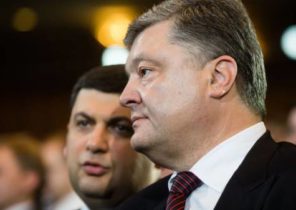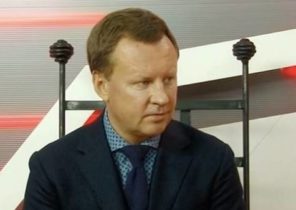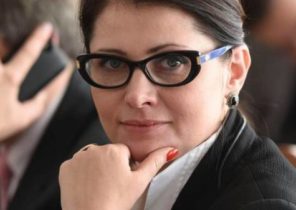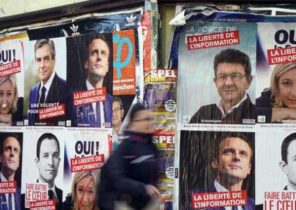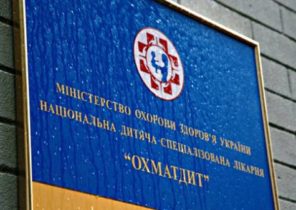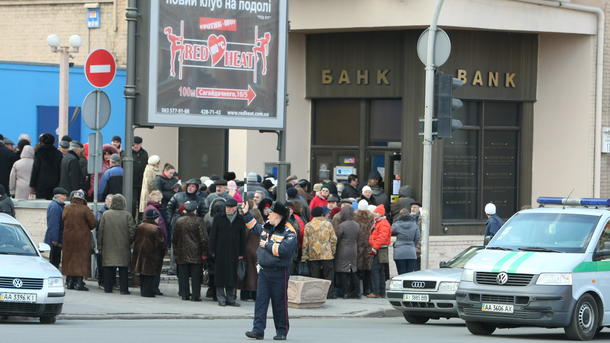
The new year holidays Ukrainians brought another round of devaluation of the national currency: Yes, for 10 days, the dollar has appreciated by 40 kopecks. This means that a dollar today in purchasing ranges 27,31 UAH, and in the sale — about 27,99 UAH The restless behavior of the hryvnia during the holidays can not to disturb our readers. So “Today” has asked experts to predict what awaits the financial sector in early 2017.
In particular, we figured out what the dollar against the hryvnia is set in the first quarter, what rates are expected for loans and deposits, can be closed and new banks. His vision shared with us the Executive Director of the NABU Elena Korobkova and finanalitik Ivan Nikitchenko. Read more in the traditional Bank review.
RATE: HRYVNIA WILL WEAKEN TO 28.5 UAH/$
This month, the national currency will depreciate moderately, the Executive Director of NABU Elena Korobkova. “This situation was observed in the beginning of 2016, when less than a month in exchange dollar jumped to RS 27 and then fell back to 25 and remained so until the fall. This year in January the situation could be repeated. In addition, the nationalization of the largest Bank of the country also pushed the dollar upwards. Also increased demand for cash currency will remain that continues to put pressure on the exchange rate,” explains Korobkova. According to her, the budget for 2017, the Cabinet laid the average exchange rate of 27.2 UAH fluctuations to 27.8 UAH to the end of the year, but the rate may be slightly higher. “We expect that in the first quarter of 2017, the hryvnia exchange rate will fluctuate in the range 27,5—28,5 UAH/$,” — said the expert.
While Elena Korobkova notes that non-standard force majeure, which could cause a serious jump course at the beginning of the year should be expected. “Fluctuations of the hryvnia is possible in the range of 10%, which today stands at about 2.7 UAH. Such fluctuations are not considered to be critical if they do not happen in a short period. Last year, the jump was sudden, which caused public concern and excitement in the market. How will be this year is difficult to predict. But the course set, and in the spring the situation will be better,” stresses Korobkova.
In these circumstances, the NBU will stick to the previous strategy, the free exchange rate. “This course has brought positive fruits to Ukraine, because we were able to rein the galloping inflation from 43.3% in 2015 to 13% by the end of 2016. The regulator, as before, will come up with interventions on the interbank market to smooth out the imbalances. Enough currency reserves — about $15 billion,” — said Korobkov.
BANKOPAD: LARGE WILL BE AFLOAT
Experts believe that in 2017 will continue bankopad, but how many financial institutions will leave the market in the first quarter, it is difficult to predict. “Banks will be closed until then while in Ukraine will not start a considerable growth in the economy and will not resume long-term loans, and it takes at least 2-3 years. That is, the financial sector needs to stabilize and start making the classic way — on mortgages and business loans. And while Ukraine has not recovered from the crisis, banks only think about survival, so operating be only two models — short-term retail lending and services to corporate customers”, — says economist Ivan Nikitchenko. Speaking about the prospects bankopada in the country, economist notes: large banks are unlikely to close. “A real bankruptcy among small establishments that are closed, merged or changed owners. It is also possible to change owners of several Russian banks, but they will continue to work,” said Nikitchenko.
But how many financial institutions will remain in Ukraine up to bankopada, it is hard to predict. “There was a time when there were more than 180, and the system worked profitably. But many banks were engaged in money laundering rather than the classic banking operations. Therefore, it is important to achieve a high quality of banking services, wide range, reliability, and regional coverage offices and ATMs,” — said Nikitchenko. According to him, if to consider the foreign experience, there are different banking system: “In Germany, 3/4 of the market in 1500 regional savings banks. In Poland customers have enough 60 banks, Turkey — 50, Romania — 40, Bulgaria — 30. So we can estimate that in Ukraine from 98 existing today banks can remain only 70-80. In principle, this is enough for the country.”
CONTROL. According to experts, banks have not fully recovered from the crisis, so it is important to keep savings, if we are talking about deposits in different currencies. Generally, accumulation can be stored on the principle of three parts: 30% in dollars, euros and local currency. “Division of savings will allow you to save money if the banks have problems with solvency or some of the currencies will depreciate. And this is a good option if you need funds in connection with force majeure circumstances”, — says Elena Korobkova. According to her, if the amount of savings exceeds 200 thousand UAH, government guaranteed, savings should be divided into several deposits and put in different banks. “Do not chase high rates. As this may indicate a problem Bank. If the financial institution offers investors 27% per annum and an average rate of 17%, it is worth considering whether to trust the Bank”, — said Korobkov. An expert advises you to carefully read the Deposit agreement, before signing, to avoid the prolongation, hidden fees or other uncomfortable conditions.
CREDITS: STRICT REQUIREMENTS AND RATES
The first quarter of 2017 will be a turning point for lending, says economist Ivan Nikitchenko, but this winter will continue the trends of last year, when there was market stabilization and slow decline rates. According to the NBU, at the end of 2016 average interest rates on hryvnia loans to individuals decreased from 33% to 31%, and business customers — from 20% to 16%. That is, the spring, the loan may be cheaper for a maximum of 1-2%. “The main problem is not the cost of credit, and the difficulty of obtaining them. Banks to strictly assess the applications and are willing to lend only short-term programs with terms of more than 1-3 years is almost there. Financial institutions actively give short-term consumer credits and credit cards to the population, with a limit of several thousand hryvnia. If a person wants to get credit for cars and housing, he will have to show official income is twice higher than the monthly payment on the loan in the 20-30 thousand UAH”, — explains Nikitchenko. According to experts, major changes in the market can be expected by the end of the year: “If our economy continues stabilizing, the fall, one can expect new Bank offers with cheaper rates on loans.”
DEPOSITS: THE CONDITIONS NECESSARY TO EQUALIZE
Deposit rates continue to fall, and this will affect the deposits in the national currency and in foreign currency, experts say. However, the lower rates will be smooth, so in the first quarter of 2017, it is unlikely that the fall will exceed a few percent. “First rate on deposits must decrease “PrivatBank”, after it was nationalized. And other state-owned banks, which already covers 51% of the banking market in the country. Especially the reduction of interest rates, it is advisable after the adoption of the presidential law on a 100% state guarantee for all private deposits in all the banks owned by the state, explains the situation to the Executive Director of the NABU Elena Korobkova. — This is the average hryvnia rate on the market. Banks with good reputation keep them in the range of 8-12%. “PrivatBank” offers its depositors and 20% annually in local currency. Thus, the government violates all the principles of healthy competition in the market, because in 2009-2016 years the authorities have invested in state-owned banks was $12.2 billion Such sums being invested, and the guarantee is still transferred to the budget, ie taxpayers. Therefore, the imbalance of the working conditions of banks need to align and create equal conditions for both public and commercial banks. This will allow including to attract foreign investment in the banking sector of Ukraine”.
At the same time, Elena Korobkova reminds us that today on foreign currency loans for a period of 12 months, rates are kept within such limits: dollar Bank customers can get an average of 5.85%, in Euro — 5%. “For the same deposits, but at a lower deadline rate in the range of 4-5% for the dollar and 3-4% for Euro. And I do not think that in early 2017 the situation will change significantly. That is, the rate will grow, because banks are not interested in attracting large foreign currency deposits, as lending in foreign currency was prohibited, and still have strict foreign exchange restrictions for business”, — says Korobkov.
